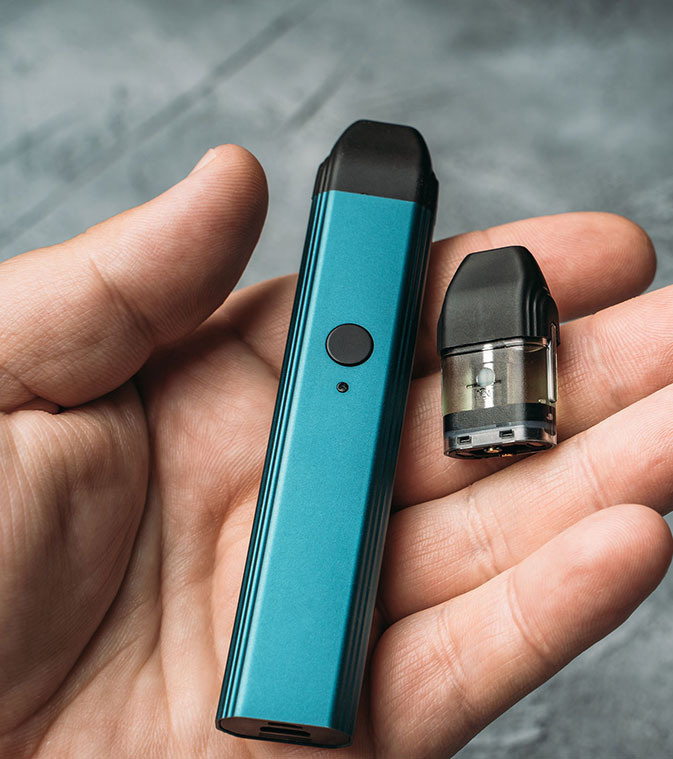ELECTRONIC CIGARETTES
& VAPOR PRODUCTS

Electronic cigarettes (e-cigarettes) (also known as e-cigs, mods, vape pens, vapes, tank systems, or electronic nicotine delivery systems) are nicotine-delivery devices that produce an aerosol by heating a liquid (usually containing nicotine) that users breathe into their lungs. E-cigarettes come in many shapes and sizes. Most have a battery, a heating element, and a place to hold the liquid.
Some e-cigarettes look like regular cigarettes, cigars, or pipes. Some look like USB flash drives, pens, and other everyday items. Larger devices such as tank systems, or “mods,” do not look like other tobacco products.
E-cigarettes and vape pens are the latest examples of how the tobacco industry targets youth to gain replacement smokers through developing and marketing new products. E-cigs are attractive to teens because of enticing flavors, cheap prices, easy purchase access, and ease of concealment. The nicotine delivered by these products, much like traditional cigarettes, creates addiction. In 2018, the US Surgeon General urged the country to immediately address the epidemic of youth e-cigarette use.
In 2019, 43.7% of Nevada high school students admitted having used e-cigarettes. And the number of students using e-cigarettes has increased in the last few years, with Nevada middle school students admitting to using e-cigarettes and vapes in the past 30 days increasing from 6.7% in 2017 to 12.0% in 2019 (UNR, 2020).
Senate Bill 263 (SB263), passed in the 2019 Nevada Legislative session, helps to fund statewide and local efforts to address the increasing rates of youth e-cigarette use and nicotine addiction.
NTCSC has worked to protect youth from nicotine addiction by:
- Helping to shape laws in Nevada to add use of e-cigarettes to the Nevada Clean Indoor Air Act (NCIAA).
- Assisting with instituting restrictions on age of purchase of e-cigarettes and implementing taxes on e-cigarettes. Youth use decreases when price increases.
- Educating youth, parents and other adults statewide about dangers of e-cigarettes and how youth can get help quitting.
Other Tobacco Products
For more information on OTPs, visit one of NTCSC’s member organizations: Southern Nevada Health District Other Tobacco Products.
Sources: CDC, World Health Organization; US Surgeon General’s Report; University of Nevada, Reno
Flavors & Marketing Make E-cigarettes Appealing to Youth
Many e-cigarettes come in various flavors, including fruit, candy, mint, and menthol. The vast majority of youth use flavored e-cigarettes, and studies have shown that flavors are the main attraction to start and continue using vapor products.
84.7%
Most youth who reported using e-cigarettes
used flavored varieties, According to the 2021
National Youth Tobacco Survey
Among middle and high school students who currently used any type of flavored e-cigarette in 2021, the most commonly used flavors were fruit (71.6%), candy, desserts, or other sweets (34.1%), mint (30.2%), and menthol (28.8%).
On January 2, 2020, the US Food and Drug Administration (FDA) finalized an enforcement policy that prohibits the sale of prefilled cartridge e-cigarettes in any flavor other than tobacco or menthol, unless authorized by FDA. The FDA and Congress have since taken additional steps to prohibit certain companies from selling youth-appealing, flavored disposable e-cigarettes and flavored e-liquids without authorization, including those containing synthetic nicotine.
Additionally, several states and communities have restricted the sale of flavored tobacco products, including menthol-flavored products, in their communities. Nevada has yet to do this.
E-cigarettes are also advertised using the same themes and tactics that have been shown to increase youth initiation of other tobacco products, including cigarettes.
In 2016, about 7 in 10 middle school and high school students (69.3%)—more than 18 million youth—said they had seen e-cigarette advertising. Widespread advertising for e-cigarettes, including product placement and via media for which advertising for conventional tobacco products is prohibited (e.g., TV), and the lower costs of some e-cigarettes relative to regular cigarettes has contributed to use among youth.
Source: CDC
Synthetic Nicotine
A new wave of synthetic nicotine products is emerging on the market, raising regulatory questions and health concerns as youth vaping continues at epidemic levels.
The disposable e-cigarette Puff Bar and oral nicotine products Bidi Pouches, NIIN and Rush are a few of these new products marketing synthetic nicotine, or nicotine that was created in a laboratory and not derived from tobacco. These new products, which have not been through the required regulatory review and approval processes, also come in flavors that are proven to attract youth.
While it is too early to know whether the health effects of synthetic nicotine are different from those of tobacco-derived nicotine, we do know that these products threaten to addict more young people.
These products have raised questions about whether they should be regulated as tobacco products or drugs, and some companies have proceeded as if they are exempted from FDA regulation altogether.
In March 2022, Congress granted the FDA the authority to regulate synthetic nicotine products under their tobacco regulatory authority.












